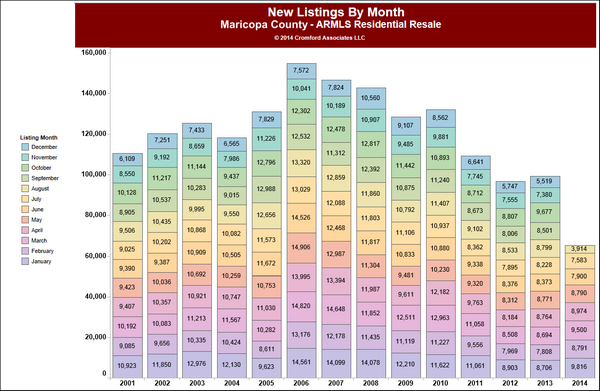Prediction Is Very Difficult, Especially About the Future – Niels Bohr (1885-1962)
Niels Bohr certainly knew what he was talking about –and the intervening years have done nothing to change that sentiment. Buyers and sellers, and their agents, have continued to struggle to interpret our market movements. As most of our readers know, demand – and the lack thereof – has been the defining element in this market. Much speculation has formed around this issue – with some just ignoring 2014 altogether and predicting demand will be “normal†by 2015. Any lacking demand in the resale market has most assuredly shown up in the rental market as people must live somewhere – causing available rentals to drop to very low numbers, in the range of only a 30 day supply. Escalating demand for rentals eventually result in escalating demand for homeownership as rental rates rise. At some point it becomes much more attractive financially to own than to rent.
If dramatic market shifts aren’t stressful enough to try to predict and understand, now add in valuation challenges. Whether buying or selling, determining the value of the home in a highly unpredictable market can be difficult. The more challenging the establishment of value, the more consumers seem to want to take research in to their own hands. Uncertainty seems to create the need for multiple sources of information- i.e. automated valuations from the internet. The most famous of these sources (or in our opinion, infamous) is Zillow. This begs the question – to whom should you trust the valuation of your largest asset or purchase? To whom should you turn to understand the market trends and shifts? Understandably, we have our own bias – but let us defer this issue to the one and only Michael Orr of the Cromford Report: Â
“Unfortunately Zillow® has decided to provide 12-month forecasts for home values. Since the figure given is a forecast for the Zestimate® value, it does not necessarily have any relationship to real market value. On the other hand, this means it can never really be challenged because the Zestimate is created by Zillow in the first place. In the past Zillow Zestimate’s have often been greatly divergent from real market values. In the cases I have watched they have often been extremely volatile for no apparent reason, sometimes rising or falling by 10% or more in just a few weeks. I have also seen Zestimates that were 80% below or 200% above true market value, though this sort of aberration seems to be getting rarer.
In the past Zillow forecasts for the wider market have not proven to be at all accurate, so I despair at the thought that ordinary members of the public will take them seriously for individual homes. Giving a percentage change to one decimal place gives a false impression of precision for a number that is more likely to be wildly wrong than close to accurate.
In the case of my own home, Zillow is forecasting a loss in Zestimate of 1.3% over the next 12 months. That doesn’t seem too unlikely, quite frankly, but their Zestimate for my home has dropped 2.9% in just the last month and 8.2% in the last 6 months. In fact 6 months ago their Zestimate for my home was ludicrously high – some 20% higher than any other automated valuation I could find. Meanwhile Trulia’s estimated value for the same home has rocketed upward in the opposite direction during the same 6 months and they are now higher than Zillow. Home owners tend to believe the highest number they can find. The variation between these automated valuation tools is enormous and there is no evidence that Zillow’s is better (or indeed any worse) than the 25 or so other tools I have seen.
The fact is that a real appraisal or professional CMA are the only sensible ways to estimate a home value. Even these can vary a lot depending on who conducted them, and Zillow’s Zestimate numbers really should be used for entertainment purposes only. As long as they are used purely for entertainment value they not a problem. Unfortunately ordinary members of the public tend to think there is some real world basis for them, which provides nothing but problems for real estate professions who actually know what they are talking about.
For those interested in how accurate Zillow’s forecasts have been in the past … Zillow Chief Economist: Stan Humphries … in February 2012 predicted that Phoenix metro home values would increase by 0.6% between December 31, 2011 and December 31, 2012.
The actual change in average $/SF was 29.5%, so Zillow was only wrong by 28.9 percentage points.
For the country as a whole, Stan predicted a 3.7% decline in values during 2012 and no housing bottom before 2013. Funny how they never mention that any more.
The Zillow prediction for 2013 was for national home values to rise by 3.3%. Phoenix area values were predicted to rise by 8.5%. Phoenix actually rose by 16.7% in 2013 and the national increase was about 13%. Again there is almost no correlation between Zillow’s forecast and what actually happens. However I must admit that the 2013 forecast was a big improvement over the 2012 one.
In case you think I am picking on Zillow, I am not. Their forecast was actually better than many. We quote Jed Kelko, Chief Economist at Trulia: “Arizona’s home prices are going to fall by 7.2% between Q3 2011 and Q3 2012”. That was possibly the worst forecast in recent history, as average $/SF rose by 26.5% instead. Trulia’s error was 33.7 percentage points. Even this was not quite as bad as several forecasts produced between 2006 and 2012 by S&P / Case-Shiller / Moody’s Analytics many of which have been proven dramatically wrong during that 7 year period…â€
If you really want to know what your home is worth, just ask. I’m not bragging, I’m applying for a job …
 done to the average consumer’s perception of appreciation. If you have one year (as we did) with 47% increase in values – then the historical range of 2-5% appreciation looks pretty pathetic. But does it really when we look at a â€real life†scenario?
done to the average consumer’s perception of appreciation. If you have one year (as we did) with 47% increase in values – then the historical range of 2-5% appreciation looks pretty pathetic. But does it really when we look at a â€real life†scenario?





